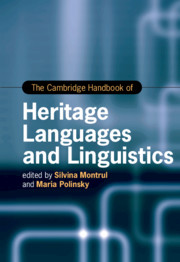Book contents
- The Cambridge Handbook of Heritage Languages and Linguistics
- Cambridge Handbooks In Language And Linguistics
- The Cambridge Handbook of Heritage Languages and Linguistics
- Copyright page
- Dedication
- Contents
- Figures and Tables
- Contributors
- Acknowledgments
- Introduction
- Part I Heritage Languages around the World
- Part II Research Approaches to Heritage Languages
- 15 Heritage Language Research and Theoretical Linguistics
- 16 The Emergence of Heritage Language
- 17 Sociolinguistic Approaches to Heritage Languages
- 18 The Psycholinguistics of Heritage Languages
- 19 Contact Linguistics and Heritage Languages
- 20 A Narrative-Ethnographic Approach to Research on Heritage Language Development
- 21 Corpus-Based Methodologies in the Study of Heritage Languages
- 22 Current Trends and Emerging Methodologies in Charting Heritage Language Grammars
- Part III Grammatical Aspects of Heritage Languages
- Part IV Heritage Language Education
- Index
- References
19 - Contact Linguistics and Heritage Languages
from Part II - Research Approaches to Heritage Languages
Published online by Cambridge University Press: 04 November 2021
- The Cambridge Handbook of Heritage Languages and Linguistics
- Cambridge Handbooks In Language And Linguistics
- The Cambridge Handbook of Heritage Languages and Linguistics
- Copyright page
- Dedication
- Contents
- Figures and Tables
- Contributors
- Acknowledgments
- Introduction
- Part I Heritage Languages around the World
- Part II Research Approaches to Heritage Languages
- 15 Heritage Language Research and Theoretical Linguistics
- 16 The Emergence of Heritage Language
- 17 Sociolinguistic Approaches to Heritage Languages
- 18 The Psycholinguistics of Heritage Languages
- 19 Contact Linguistics and Heritage Languages
- 20 A Narrative-Ethnographic Approach to Research on Heritage Language Development
- 21 Corpus-Based Methodologies in the Study of Heritage Languages
- 22 Current Trends and Emerging Methodologies in Charting Heritage Language Grammars
- Part III Grammatical Aspects of Heritage Languages
- Part IV Heritage Language Education
- Index
- References
Summary
This chapter presents an overview of heritage speakers’ linguistic outcomes with the goal of bringing some answers to longstanding debates in contact linguistics. Of special interest are mechanisms of contact-induced change such as convergence and grammaticalization, the role of transfer and priming in those processes, and whether or not these processes lead to simplification or complexification in heritage grammars. Overall, the evidence in the literature favors the argument that syntactic material rarely gets transferred, and that patterns of convergence toward the dominant language are a byproduct of other mechanisms. Contrary to proponents of the theory that social factors take a secondary role in contact-induced grammaticalization, it has also revealed that contact-induced grammaticalization processes in heritage grammars are dependent on the social dynamics of the community. While priming may lead to converge, such effects are also heavily dependent on the social dynamics of the heritage speakers. Results also indicate that patterns of simplification and complexification are intrinsically linked to usage. The discussion makes a call for more work considering intersubjective factors in the study of heritage grammars, in an attempt to better understand the relationship between linguistic systems and social structures.
Keywords
- Type
- Chapter
- Information
- The Cambridge Handbook of Heritage Languages and Linguistics , pp. 471 - 498Publisher: Cambridge University PressPrint publication year: 2021



